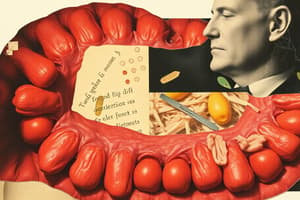Podcast
Questions and Answers
What is the main role of digestive enzymes in human digestion?
What is the main role of digestive enzymes in human digestion?
Where does digestion begin in the human body?
Where does digestion begin in the human body?
Which gland produces amylase, an enzyme that helps break down starch?
Which gland produces amylase, an enzyme that helps break down starch?
What happens to food in the stomach?
What happens to food in the stomach?
Signup and view all the answers
Where do pancreatic enzymes primarily act during digestion?
Where do pancreatic enzymes primarily act during digestion?
Signup and view all the answers
What is the source of most digestive enzymes involved in human digestion?
What is the source of most digestive enzymes involved in human digestion?
Signup and view all the answers
What is the primary role of amylases in the digestive process?
What is the primary role of amylases in the digestive process?
Signup and view all the answers
Which enzyme is responsible for breaking down dietary fats into monoglycerides?
Which enzyme is responsible for breaking down dietary fats into monoglycerides?
Signup and view all the answers
What is the main function of bile acids in digestion?
What is the main function of bile acids in digestion?
Signup and view all the answers
Which substance stimulates pancreatic enzyme production and pancreatic juice flow?
Which substance stimulates pancreatic enzyme production and pancreatic juice flow?
Signup and view all the answers
What is the role of proteases in the digestion of proteins?
What is the role of proteases in the digestion of proteins?
Signup and view all the answers
How do the liver enzymes Alcohol dehydrogenase and Glucuronidation contribute to digestion?
How do the liver enzymes Alcohol dehydrogenase and Glucuronidation contribute to digestion?
Signup and view all the answers
Study Notes
Understanding Human Digestion, Focusing on Digestive Enzymes
Human digestion is a complex process that breaks down food into smaller molecules so our bodies can absorb essential nutrients. This intricate system relies heavily on specialized proteins called digestive enzymes, which enable us to efficiently extract energy, vitamins, minerals, and other important compounds from the foods we eat. In this exploration of human digestion, let's delve deeper into these remarkable biological catalysts.
Overview of Digestion
Digestion begins when we chew our food. Saliva produced by salivary glands contains amylase, which starts breaking down carbohydrates like starch before they enter the stomach. After swallowing, food moves through the esophagus into the stomach where it encounters hydrochloric acid and other enzymes. From there, the partially digested food enters the small intestine via the pancreatic duct and bile duct.
Inside the small intestines, various digestive enzymes work together to continue the breakdown process. These enzymes originate mostly from three main sources: the mouth (salivary glands), pancreas, and liver cells secreting bile into the gallbladder. Let's examine some key examples below.
Pancreatic Enzymes
The pancreas produces several important enzymes that reach the small intestine in an alkaline environment thanks to the release of sodium bicarbonate from its duct cells. Some of these enzymes are:
- Amylases: Continue breaking down carbohydrates, especially maltose and maltotriose, into simpler sugars like glucose and fructose.
- Lipases: Break down dietary fats such as triglycerides into monoglycerides, fatty acids, and glycerol.
- Proteases: Break peptide bonds within polypeptides to form shorter chains or individual amino acids, facilitating protein digestion. There are multiple types of proteases with different specificities.
Bile Acids and Liver Enzymes
Bile acids help emulsify lipids, making them more accessible to lipases, while also regulating cholesterol absorption and excretion. The primary bile acids include cholic acid, chenodeoxycholic acid, deoxycholic acid, and lithocholic acid. Additionally, the liver plays a role in producing two enzymes crucial to processing certain macronutrients:
- Alcohol dehydrogenase: Metabolizes alcohol into less toxic products like acetaldehyde and eventually acetic acid.
- Glucuronidation: A phase II detoxification reaction involving conjugating drugs, hormones, and xenobiotics with glucuronic acid, preparing them for elimination.
Furthermore, the liver releases a substance known as secretin, which stimulates pancreatic enzyme production and pancreatic juice flow.
Summary and Conclusion
Understanding how digestive enzymes function helps us appreciate their critical roles in human nutrition and overall health. While many factors contribute to efficient digestion, digestive enzymes warrant special attention due to their unique ability to break down macromolecules into forms that our body can utilize effectively. It's fascinating to consider the complexity behind our ability to harvest energy and build cells from the foods we consume each day.
Studying That Suits You
Use AI to generate personalized quizzes and flashcards to suit your learning preferences.
Description
Delve into the intricate process of human digestion and the crucial role of digestive enzymes in breaking down food for nutrient absorption. Learn about pancreatic enzymes, bile acids, liver enzymes, and the overall significance of these biological catalysts in maintaining optimal health.




